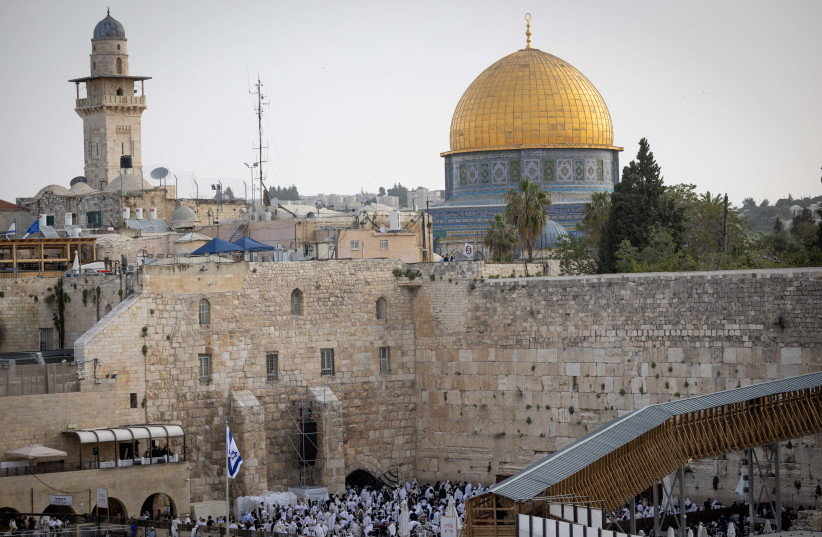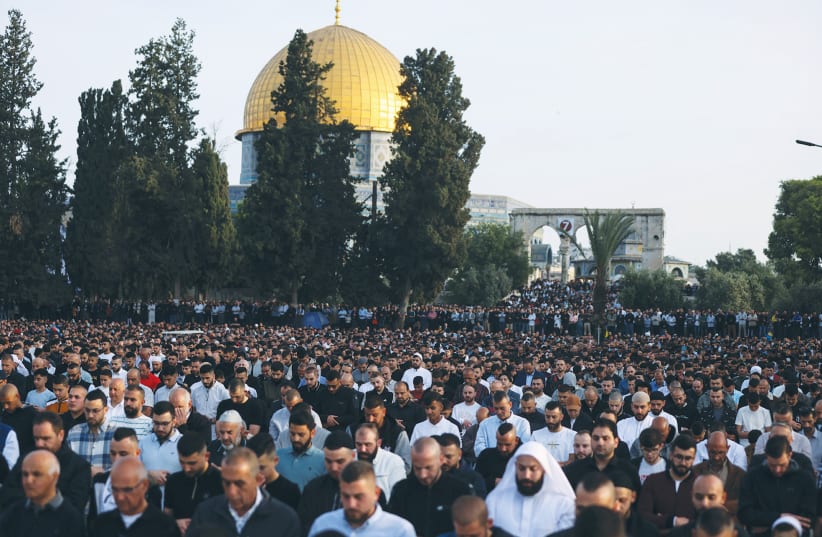We have made it through the spring holiday season without another war, although it was touch-and-go almost every weekend. Five Palestinian terrorist attacks left 15 Israelis dead, and Israeli forces killed 27 Palestinians during the same period, many of them non-combatants. Islamic Jihad in Gaza shot at least two rockets into Israel, and Israel retaliated by bombing Hamas and Islamic Jihad installations in Gaza.
Hamas spokespeople in Gaza, Lebanon and Qatar encouraged all Palestinians in the West Bank, Gaza and Israel to protect al-Aqsa Mosque from what they believe are Israel’s plans to either destroy the mosques on the Temple Mount, or divide them between the Jews and the Muslims.
Jewish fanatics tried to sacrifice goats on the Temple Mount during Passover, and thousands of Jews who want to see the Temple built in place of the mosques ascended the Temple Mount to pray.
Every Friday morning during Ramadan, there were violent incidents between young Palestinians in the al-Aqsa compound and the Israeli police. This led to the massive use of tear gas by the police; stones, fireworks and other objects were thrown by Palestinian youths at the police and at the Kotel complex below.
Hundreds of young Palestinians were arrested and most were subsequently released. Hundreds of Palestinians were wounded by Israeli police violence within the al-Aqsa compound. Despite that, hundreds of thousands of Palestinians came to al-Aqsa throughout Ramadan to pray and to share their iftar breakfast meals together.


THE MOST holy site in Jerusalem – al-Aqsa Mosque for Muslims and the Temple Mount for Jews – has once again become the rallying point of ultra-nationalism coupled with religious fervor and a lot of violence. Throughout Ramadan, small groups of flag-waving Palestinians attempted to claim ownership or leadership by waving the flag of their faction, or by chanting their slogans.
This happened, but it was highly exaggerated in the Israeli media. In reality, it was only small groups of flag waivers, mostly from Hamas, who tried to rally the crowds around their political movement. Most of those praying on the Temple Mount did not join in.
When al-Aqsa/The Temple Mount becomes the focal point of violence in the Israeli-Palestinian conflict, the holy site loses its sanctity and the conflict becomes a lot more dangerous.
As my good friend and colleague, Samer Sinijlawi, wrote on his Twitter account: “Al-Aqsa is the house of God and it is wise to leave it for worship instead of turning it into an arena for factionalism. The factions’ leadership must issue a decision to its members and supporters to prevent the raising of partisan banners and chants inside al-Aqsa. The Wakf, the mufti, and the preachers must put an end to this phenomenon. Al-Aqsa is for all to worship only.”
Samer visited and prayed in al-Aqsa almost every day of Ramadan. I believe that his sentiment reflects the feelings of most of the people who went to pray there during the holy month.
HERE ARE some proposals for us all, Jews and Muslims, that would make the holy sites holy again and ensure that they will not continue to be the center of religious and national violence.
As part of the Israeli-Jordanian peace treaty, it was agreed that Jordan will retain its special role on the al-Aqsa compound. Article 9 of the treaty states:
“1. Each Party will provide freedom of access to places of religious and historical significance. 2. In this regard… Israel respects the present special role of the Hashemite Kingdom of Jordan in Muslim holy shrines in Jerusalem… 3. The Parties will act together to promote interfaith relations among the three monotheistic religions, with the aim of working toward religious understanding, moral commitment, freedom of religious worship, and tolerance and peace.”
This article is the basis of Jordanian support to the (Palestinian) Wakf to remain in place as protector and manager of al-Aqsa, but it is essential to enact the other aspects of this article.
My first proposal is that the chief rabbi of the Kotel and the Kotel Administration, together with the mufti and the heads of the Wakf, enter into a series of learning and teaching together on the religious significance of the places holy to Islam and Judaism.
Respected religious leaders with a lot of experience in interfaith work should conduct the initial learning sessions. People like Rabbi Michael Melchior, and perhaps Sheikh Abdulkarim Zorba from al-Aqsa could lead the first two sessions; others can lead subsequent sessions.
These sessions should take place on al-Aqsa and by the Kotel, in rotation, and it should be a regular monthly study session.
During the coming year, the Wakf and the Kotel administrations should organize visits by members of all faiths, led by officials of each respective side on site. The visits should be defined as religious lessons about the two faiths and the role of the holy places in faith and ritual.
Visits should be encouraged and specific times should be set for them. In keeping with the status-quo agreements, hours for visits to al-Aqsa should remain during non-prayer hours. Instead of Jewish guests being led around the al-Aqsa compound by the Israeli police, Wakf officials and religious teachers should lead them.
The visits should not be solely for the purpose of tourism, but for study and gaining insight and understanding about the religious significance of the site to those who are allowed to pray there – Muslims in al-Aqsa and Jews at the Kotel.
If for one year it can be decided by the leaders of the religious communities that mutual visits are to be conducted for the purpose of learning and understanding, perhaps we can avoid the provocations that we have seen over the past months.
Perhaps at a later time (even much later), when relations are greatly improved, people could be invited to pray together at all of the holy sites where they all pray to the same God.
Israel Police and the Wakf officials should be invited to Jordan for a discussion on issues concerning security on the mount. The outcome of the meeting should be that the Wakf officials will ensure that no stone-throwing will take place from the mount toward the Kotel. If Wakf officials manage to keep law and order on top, then no Israeli police will enter the mount during prayer time.
The only time when Israeli police may enter is during the limited number of hours of Jewish visits, to ensure that no Jewish prayer or provocations will be held, and that the Jews will be protected. The task of protecting non-Muslim visitors is the Wakf’s.
The Israeli side will remove the model of the Temple at the entrance of Mughrabi Gate, which seems to serve as a reminder that the Jewish goal is to replace the Dome of the Rock with the Jewish Temple. The location of the model there is a clear provocation and should not be there at all.
These are just some of the positive suggestions that I could make.
The writer is a political and social entrepreneur who has dedicated his life to the State of Israel and to peace between Israel and her neighbors. He is now directing The Holy Land Bond.
